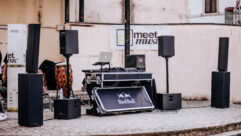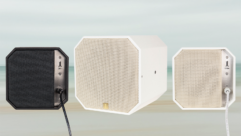
Worship Sound System Upgrade: On Rigging and Nexo Geos, Part 1
Oct 4, 2012 2:32 PM
With Bennett Liles
Listen to the Podcasts
|
Editor’s note: For your convenience, this transcription of the podcast includes timestamps. If you are listening to the podcast and reading its accompanying transcription, you can use the timestamps to jump to any part of the audio podcast by simply dragging the slider on the podcast to the time indicated in the transcription.
At New Jersey’s First Baptist Church of Lincoln Gardens the membership has grown to over 6,000, and the sound system needed a substantial upgrade to handle the capacity. They called in Boulevard Pro to take out the old system and install the new one. James Cioffi is with us to tell the story on how it all got up and running, coming up next on the SVC Podcast.
SVC: James, welcome to the SVC Podcast from Boulevard Pro in Ridgefield, N.J. It’s been a while since your outfit has been on the podcast so what’s been going on lately at Boulevard Pro?
James Cioffi: Hi, how are you? Boulevard Pro is very proud to have been awarded the Sound Company of the Year from Front of House magazine for the northeast region of the United States, so we’re very proud of that and over the last year we moved into a new facility. We have a new warehouse, and we’ve consolidated all of our installation and production staff under one roof. That’s been really helpful over the last year and we’ve been doing design build jobs, and we just came across a really nice one that I wanted to talk to you about. It’s the First Baptist Church of Lincoln Gardens, N.J., and we did a very large upgrade on their sound system, and I guess we could talk about all of those things. [Timestamp: 1:39]
Yeah, the First Baptist Church of Lincoln Gardens sounds like a pretty ambitious project. That church seems to just come a long way. I think it’s something like 6,000 members now. What was the tech situation at the church when they called you in? What did they need from Boulevard Pro?
Well, we were called in, they built a new sanctuary, and in the northeast, where we’re from, there’s not a lot of big super churches; this is obviously a very large church. It has 3,500ft., and it’s packed to capacity all weekend during their services, and they have a very robust music ministry, and when we got in there, they was a left right center array of between probably 8-9 years ago. And it was a wonderful system, but what happened was that their music ministry has outgrown the system that was in place. So we were called in by the tech crew to come up with just an installation idea what we thought would upgrade the space and we came in with a line array system and then we started working from there, but that’s where we started. We started in when there was a professional system of older technology put in the room, that’s really what we came into. [Timestamp: 2:47]
OK, and of course when you walk into a place like this, I guess if there’s any kind of sound going on you evaluate the situation. What was your impression of the acoustics when you first heard it?
The system was an older three-way regular standard like VA-type of sound system, a vertical array, and it consisted of a left/right center. In the left/right center were two three-ways and a sub, and it was not really super high powered but very, very good for speech intelligibility. It wasn’t really aimed in a great place because they put it into the soffit of the architecture of the church, so it really, given the place where it was, it wasn’t in a great position from the get go. But I think they did that so it could be completely concealed. It was behind grilles; you couldn’t see it, and with the new regime that came into the church, obviously they said we don’t mind seeing the speaker array and then having said that, is when they started the process of interviewing designers and sound install companies on their ideas and went out to bid and our design was accepted. [Timestamp: 3:55]
OK and when you started taking out the old system was there any part of it that you decided to keep or modify or work into the new one?
Well, we didn’t keep any of the old gear. We did use some existing rigging points that happened to line up to where we were. We did use the center array cavity to install the line array sub woofers and that was something that we came up on the job because there were conversation of where the subs were going to live and one of our technicians came up with a pretty ingenious rigging solution, and they got these two cameras up in the air and then it worked out great. So you can’t see the subs; you just see the line array left and right. [Timestamp: 4:37]
And that was Johnny Orth I believe who came up with that idea?
Yeah, John Orth; he came up with the rigging thing. Justin Spencer is the inhouse audio chief and a very seasoned live sound-touring engineer with a lot of name bands as well. So he and I were coming up with solutions where we were going to put [the subs] in the center of the room anyway, so they thought if we could do them in an omni configuration up in the ceiling that would work really well. And it just so happened that John came up with a really ingenious way of hanging them and he got them right in there with probably an inch on each side to spare. t was great; it was pretty cool. [Timestamp: 5:15]
Worship Sound System Upgrade: On Rigging and Nexo Geos, Part 1
Oct 4, 2012 2:32 PM
With Bennett Liles
Well that’s great when something like that works because rigging is obviously one of the hardest parts of doing these things. Yeah and making it look like something at the end of the day was another thing. It’s a beautiful environment, and there are some pictures around of that and I think there was an article or two in the press, but there are some pictures. It’s really a wonderful looking space. The subs being in that cavity really helped. [Timestamp: 5:38]
OK, now what did you decide to go with on speakers for this? You went with a Yamaha system?
We’re a Yamaha commercial sound dealer, and we do a lot of business with them. We have a very good relationship, and we speced in a Nexo GEO S12 line array system. We have five cabinets per side; four of them are the GEO S1210s and there’s a GEO S1230 to down fill on each side. We use all the Nexo flyware, the Expo boxes, and their touring bumper, and it was a very complete system. We used the Nexo NS1 software to do a analysis of the room and decide where the proper location and camera and tilt would be, and it worked out pretty well. [Timestamp: 6:26]
You mentioned that they didn’t mind seeing the speaker arrays. I guess that’s a very contemporary worship style they have going on there. I would think that with the more traditional churches it’s a lot easier when they don’t have all the live music.
You know, it’s really about the horsepower. These guys, this is as much level as any rock concert. It’s a serious gospel band, full band, full drum set, bass player, two keyboard players, B3 player. Its serious choir, over a hundred -voice choir, so it’s a lot of information and plus Joe Spencer is a very, very talented engineer and he was able to control it. hey have an onstage monitor mix. There’s also a television broadcast being done at the church, so it’s a pretty serious environment so it needed a professional space. We’re out of all the sight lines for the cameras and the lighting. That was another concern, but we’re out of all that so you don’t really see that in the show. [Timestamp: 7:21]
So in this kind of high-powered sound environment how did you set up the choir monitoring?
The choir monitoring—we used Yamaha IF2108s in white, and we hung them from the lighting rig, and you can’t even see them. The choir monitor is really most of the mix that the pastors voice—to keep him in cued in where they’re going. There’s a little bit of piano through it, but other than that, the whole environment is very up front. And there’s some floor monitors around, so there’s a lot of mixes, but we filled them in with those Yamaha’s and they worked out really well. [Timestamp: 7:58]
And you’ve got let’s see on the Geo S1230 configurable directivity?
We have two 1230s, which it’s a 100×30 degrees and the other boxes are all 10 degrees. So what we’ll do is use the down fill, put it on its own channel of processing and amplifier, and we’re able to dial in the very, very front parts of the church on a different level and a different EQ curve than the rest of the array. So we can really fine tune it. It really gives us a really sweet down fill without spilling back onto the stage and coming into feedback problems and things like that. Because the stage proscenium extends as far as the array is, because it follows the contour of the architecture of the church, this is where the old array was, in the proscenium. The stage follows it, so we had to be very mindful of where we pointed it, but it worked out pretty well. We have some front fills in as well, and there’s a barrage of floor monitors around, so there’s a lot of monitoring as well as in-ear monitoring. [Timestamp: 9:06]
A lot of live performance there, so what did you do for stage monitoring? Is it all in-ear? Have they got floor monitors, too?
Well, they have floor monitors; with the choir monitors there’s six mixes of monitors from the stage; from there is 16 mix Aviom in ear monitors that the band is using so—and they have an on stage monitoring console, a Yamaha LS9, with an Aviom card. FOH is a Yamaha M-7 48, so they’re running some full range mixes out of that to do some fills. Under-balcony executive fill on the front of the stage altar area, so there’s a lot of mixes going on. [Timestamp: 9:46]
All right, well thanks for giving us the story on the project and in part two we’ll get into the front of house mixer, the mic lines, the Aviom, and some other things they have. James, it was great having you here to tell us about it. James Cioffi from Boulevard Pro in Ridgefield, New Jersey and we’ll see you in part two.










